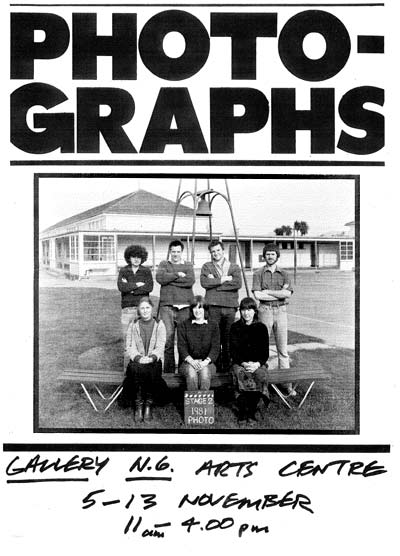“Art school also showed me at the time the best photographers were self taught, and it was their passion that got them through the lean years, and I instinctively knew, even at the time, that was the important lesson: quality would only come through passion, and giving yourself time to grow.”
|
I came down to Christchurch in 1978 when I was seventeen years old. I did a term or two at the old buildings [Okeover] and then dropped out, I was a mighty confused lad fresh from the nest and needed a year or two to get used to things. So hung around Christchurch until I was bored and restarted in earnest in 1980. I majored in photography basically to be in Laurence Aberhart's class. I'd had him and Larence Shustak my first time around and liked his approach to the course and was amazed at how he could make a photograph so mythic and otherworldly. I was initially drawn to film-making, which I still wonder if I should have done, but made the choice I made for whatever random reason. – liquor, hormones, inability to read... Laurence Aberhart was my main teacher but I really enjoyed Doris Lusk's drawing classes. I was in her class both times I attended. I seem to remember we had a technical drawing or graphic design minor we had to do, but the whole class refused to do it. I can't remember who that was under – maybe Max Hailstone. I had Tom Taylor, Don Peebles (painting), Quentin Macfarlane (painting) and I seem to remember being in Barry Cleavin's class for printmaking at some point, but I don't know how that could have happened. During my first attempt I was a student with Stuart Griffiths, who currently teaches in Dunedin. He lectured in sculpture for a couple of years at Ilam around 1978, Gary Collins and Nicola Jackson. My second time was with Ronnie van Hout, Mark Whyte, Glenn Smith (photography teacher in Dunedin), Ruth Watson, Ross Humphries, Neil Fraser, Rongotai (Mervyn) Lomas and Greg Bramwell. The social scene was okay. In the first year we'd all go down to the Bush Inn on Friday when we got off early. Later on Greg Bramwell, Guntas Atvas and I would go to the Blenheim Road Inn for lunchtime drinks. There were art school parties and Laurence Aberhart had people around to his place. I had non-art school friends so most of the parties I went to were with other groups of people. I flatted with two girls from art school in my last year – Lucinda Birch and Kirsty Clayton – and that was pretty social, beside the Caledonian Hotel. By then I was buying a lot of records and playing loud electric guitar every day, so I probably wasn't the ideal flatmate. I was unaware of all but the biggest names in art, post-modernism was gathering steam but no one seemed to know what it meant. I remember the Thyssen-Bornemisza exhibition coming in 1980 and it had some post-modern works and we puzzled over them for a while. I can't remember names, though. I have never had any idea what I would do as an occupation, even though from a young age music writing and performing was all I thought about, I had no role models or accessible local influences to even get an inkling of how it might become a career in my home town of Hastings. As far as I knew nobody did original material that was any good locally and seeing a covers band was the most excitement you could hope for in the 1970s, until punk rock hit. But I was already in Christchurch by then. Art school gave me my ticket out of Hastings; in that way it completely changed my life. I probably would have left anyway but I would have ended up in a job of some sort and not had the time to focus on the things that proved to be important to me. I find it impossible to write while working. In Sydney I had a job just walking around this huge factory and wrote a lot, but it all stank, and as soon as I left the job I wrote 'Holiday in Dakota', which appears on the first Renderers album. Art school also showed me at the time the best photographers were self taught, and it was their passion that got them through the lean years, and I instinctively knew, even at the time, that was the important lesson: quality would only come through passion, and giving yourself time to grow. I must say that years down the track the people from art school that I still see are some of the nicest people I know, possibly because we don't see too much of each other, but I always enjoy running into people from those times. Also my background did impact on my partner Maryrose when she started painting, in that her sights were set a little higher than a lot of other self-taught artists. I just assumed she would operate at a certain level or not really bother. Seeing her paint actually reinforced in me I'd made the right choices for myself. I do like to do posters and album covers but that's about as far as things go these days. |
|||||||


